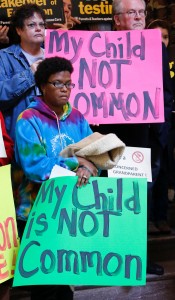Since April, when this photograph appeared in The New York Times accompanying an article entitled “Republicans See Political Wedge in Common Core,” I’ve been haunted by the disjuncture between the emphatic refusal evident on the signage and the sidelong glances of the protesters, their impenetrable expressions that allude to the uncapturable and unknowable feelings beneath, beyond, and behind the scene.
From one angle, this photograph captures a flashpoint, in which what is held among us in “common” has become conflated with educational reform vis-à-vis more rigorous standardized testing. It indexes a moment in which these collective frustrations have materialized as a bizarre, almost uncanny articulation of the very individualism that legitimizes standardized testing. “Common” is that thing way, way over there—my child is NOT common. I worry that in an age of educational enclosure, this rhetorical rejection of a common future might further foreclose alternative ways of being in common.
And yet, the photograph remains wrought with tension, performing more than just a gesture of refusal. It is simultaneously thick with a shared detachment from the scene of protest, registered in the averted glances across these faces.
I want to briefly consider how a racial history of “the commons,” might frame the dynamics of refusal and distraction at work in this image. In Black Reconstruction, W.E.B. Du Bois illustrates how, in the South, the dream of “public education for all at [the] public expense” was an African-American one (638). He mobilizes nation-feeling by calling on his readers, “men and nations,” to live up to “the greater ideals of the American Republic” and support the construction of common schools (The Souls of Black Folk 14).
Du Bois also quotes one of his most vocal opponents at length to demonstrate the public fear that African American education might threaten white supremacy, fear that later materialized as death threats and the burning of these new common schools: “We, the millionaires — we, who are paid out of your pockets, will take your money and will send our children to select high schools, to foreign lands, where no Negroes are, but you, you who are too poor to pay, shall send your ragged, hungry urchins to the common schools on such terms as we dictate, or keep them away to stray among the treacherous quick-sands and shoals of life…” (Black Reconstruction 663).
In addition to striking chords of inequality that reverberate today, what can we hear in this Southern Congressman’s description of black children—perhaps the child that the green sign alludes to—as “ragged, hungry urchins,” that should be banished to “the common schools”? What shifts if we consider how the contemporary demand for an uncommon education has historically been intertwined with the threat of a common education, articulated in rhetoric that denies humanity to those with black skin, to those who cannot pay?
I have no answers to these questions, but a few inclinations.
- That this historical flashpoint should tune us in to the unevenness of history. Although we are bound by contemporary conditions of the 99% and the 1%, precarity remains unequally distributed along embodied axes. And yet, to refuse the commons risks allowing ourselves to be divided, rather than united, by this uneven vulnerability. As a teacher once suggested to me, “without a certain feeling for the common, there can’t be education at all.” Or as Fred Moten and Stefano Harney argue, social change can only emerge from the felt sense that “this shit is killing you too” (10).
- That this photograph captures the experience of being unwillingly implicated in an American Dream. The common core, a project of national incorporation through standardization, has catalyzed a moment of national dissensus, that feeling of being out of sync with a world. Indeed, their expressions index the unraveling of this national fantasy, what it feels like to be strung along and embedded within, while recognizing the sheer inadequacy of, our nation’s preferred style of being-in-common.
- I want to suggest that by showing up in Jackson, Mississippi on the same cold day in January, these people have come together to reject one form of common-ness, and in doing so, they perform an alternative commons—one that, almost paradoxically, brings people together in their very insistence on uncommonness.
Works Cited
Du Bois, William Edward Burghardt. Black Reconstruction in America 1860-1880.
New York: Simon and Schuster, 1935.
—. The Souls of Black Folk. New York: Oxford University Press, 1993.
Harney, Stefano and Fred Moten. The Undercommons: Fugitive Planning and Black
Study. New York: Minor Compositions, 2013.


